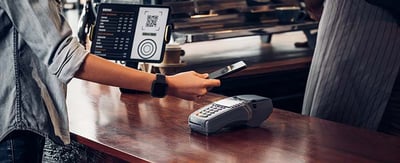
Mobile Commerce Chargebacks
By Chris Alarie on Dec 27, 2022
Mobile commerce has been an emerging form of retail business for many years and, accelerated by the changes necessitated by the COVID-19 pandemic, is now established as an essential pillar of merchant business. This offers benefits to both merchants and consumers, but also carries notable risks.
What Is Mobile Commerce?
Mobile commerce—sometimes abbreviated as m-commerce—was defined in 1997 by Kevin Duffey at the Global Mobile Commerce Forum as, “The delivery of electronic commerce capabilities directly into the consumer’s hand, anywhere, via wireless technology.” The first real world example of mobile commerce comes from that same year when two Coca-Cola vending machines in Helsinki, Finland were equipped with the capability to accept payment via SMS text messages.
In the 25 years since, mobile commerce has evolved to encompass a wide variety of commerce conducted via smartphone and other wireless internet devices. Now merchants can sell their products through applications, app stores, mobile sites, and desktop sites that can be accessed on mobile devices, among other mobile commerce means. Some merchants even combine mobile commerce with in-person shopping, through methods such as Buy Online, Pickup In Store (BOPIS). And a wide variety of alternative payment options such as digital wallets and peer-to-peer (P2P) payments further contribute to the growth of mobile commerce. Social media platforms such as Facebook, Instagram, and Pinterest have made mobile commerce fully integrated parts of their platforms, allowing merchants to directly sell their wares on those platforms.
According to LexisNexis’s 2022 edition of its True Cost of Fraud report, the percentage of U.S. retail businesses offering mobile commerce has increased from 48% in 2019 to 91% in 2022. This increase is fueled by technological changes as well as a need to meet customer expectations. Younger consumers, in particular, tend to prefer mobile commerce and those desires seem likely to accelerate these trends. Business Insider predicts that mobile commerce will account for 44.2% of all U.S. retail sales by 2025, totalling more than $700 billion.
Mobile commerce confers a number of advantages for both merchants and consumers, especially as smartphone and mobile device use catches up to desktop computer use. The personalization of using mobile profiles allows merchants to target the right consumers and makes it easier for consumers to find the sorts of products and services tailored to their interests. The convenience of shopping from anywhere, thanks to the mobility of mobile devices, serves both merchants and consumers well. And the increasing efficiency of integrated payment options reduces consumer friction. But mobile commerce also carries certain risks for merchants and consumers.
Mobile Commerce Chargebacks
Mobile commerce is generally as susceptible to chargebacks as any form of ecommerce or other retail transactions that use payment cards. While mobile commerce may be more likely to use alternative forms of payment such as PayPal, P2P, Digital Wallets, and Buy Now Pay Later (BNPL), all of those forms of payment connect to traditional payment cards in one way or another. It is possible that mobile commerce transactions may be more likely to involve cryptocurrency, which generally doesn’t result in chargebacks. But crypto carries its own, unique risks.
All of the possible sources of chargebacks that affect ecommerce can also create issues for merchants that utilize mcommerce. This includes customer confusion, poor communication, customer dissatisfaction, and all three varieties of fraud—chargeback fraud, friendly fraud, and true fraud. While mobile commerce’s basic susceptibility to chargebacks is similar to other forms of retail transactions, it faces elevated risks for some forms of fraud.
Mobile Commerce Fraud Risks
Because it often emphasizes low friction purchasing methods such as “one click purchasing”, mobile commerce has significant susceptibility to some sources of friendly fraud. These can include accidental purchases by the cardholder or instances of family fraud, in which a member of the cardholder’s family makes a purchase with the cardholder’s mobile device that the cardholder did not authorize. In particular, children accidentally making in-app purchases while playing mobile games on their parents’ phones is a frequent source of mobile commerce chargebacks.
Mobile commerce is also notably susceptible to true fraud. Some of that is simply a matter of fraudsters following the shopping trends of the public. As mobile commerce grows, it becomes a more enticing location for fraud attacks. The LexisNexis report shows evidence of this: “The mobile channel is driving the increase in fraud attacks. Year-over-year changes in average monthly attack volume is relatively unchanged for those that don’t adopt mobile commerce, while it is significantly up among those which do offer it.”
Other causes of the increased rate of fraud in mobile commerce stem directly from aspects of how mobile commerce works. The same convenience and frictionless shopping experience that makes mobile commerce enticing to consumers makes fraud prevention more difficult. According to LexisNexis, U.S. retailers report finding more challenges with digital identity verification on mobile channels, “specifically verifying email addresses, phone numbers or devices.” LexisNexis also documents the increased susceptibility of bot attacks for mobile channels, reporting that, “Synthetic identities and mass automated bot orders are complicating mobile channel identity verification efforts, again with limited use of real-time transaction risk assessment and third-party data.”
The mobile aspect of mobile commerce can raise the risks of true fraud from the side of the cardholder. Mobile devices do not always have the same level of security as desktop or laptop computers. Additionally, cardholders may conduct mobile commerce transactions over public wifi networks that lack the security of a home wifi network. Also, certain industries with higher levels of fraud risk, such as gambling and gaming, are among the industries best suited to mobile commerce.
Conclusion
Ultimately, mobile commerce is a major part of ecommerce. Merchants have either already adopted it or will do so soon. In order to reduce their susceptibility to mobile commerce, merchants need to engage in the sorts of preventative policies that can encourage well meaning consumers to resolve disputes without chargebacks—including emphasizing good customer service, facilitating easy communication, having forgiving refund policies, employing good descriptor hygiene, and clearly explaining billing procedures—as well as making efforts to prevent fraud—including utilizing anti-fraud tools and having solid anti-fraud procedures.


